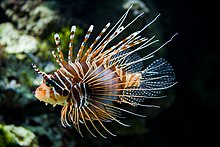 |
| Honeysuckle |
An example of deliberate introduction is that of ornamental plants such as honeysuckle (common in Indiana, originally from Asia), or livestock such as donkeys and cattle, which were brought to North America during colonial days. Lionfish, which started out as a pet for Floridians now kills up to 74% of native species in the Caribbean.
There are even invasive species that land managers have introduced as a means of combating other, pre-existing invasive species. The tamarisk, or salt cedar, tree is one. It sucks up immense amounts of water in the already-dry Southwest USA, and it is now of the most noxious invasives in the US.
 |
| Lionfish |
A current trend in the environmentally-conscious food world is eating invasive species. From the popularity of dandelion greens on fancy salads, to sushi restaurants that highlight invasive fish and seafood, to hunting down feral pigs in Texas, it's making quite a splash!
 |
| Zebra mussels |
Lionfish is apparently great-tasting. And who doesn't like ham and bacon? Plus, the feral pigs are free-range and grass-fed!
“Humans are the most ubiquitous predators on earth,” said Philip Kramer, director of the Caribbean program for the Nature Conservancy. “Instead of eating something like shark fin soup, why not eat a species that is causing harm, and with your meal make a positive contribution?” (NYT)While not a cure-all, eating invasive species can be one means of combating and removing habitat-destroying plants and animals. What do you think?

No comments:
Post a Comment